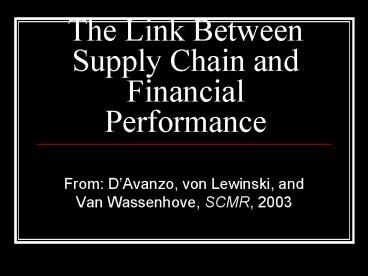The Link Between Supply Chain and Financial Performance - PowerPoint PPT Presentation
1 / 20
Title:
The Link Between Supply Chain and Financial Performance
Description:
Superior performance = top third for at least 2 of the 3 performance metrics ... Transformers SC performance improved to superior range over time ... – PowerPoint PPT presentation
Number of Views:83
Avg rating:3.0/5.0
Title: The Link Between Supply Chain and Financial Performance
1
The Link Between Supply Chain and Financial
Performance
- From DAvanzo, von Lewinski, and Van Wassenhove,
SCMR, 2003
2
Objectives of Study
- Determine impact of SC on financial performance
- Identify the drivers of financial performance
- Identify the capabilities that lead to SC
leadership - Ascertain how companies achieve SC excellence
3
Study Methodology
- Statistical analysis of publicly available data
on 636 Global 3,000 companies covering 24
industries - Consultation with industry analysts, academic
experts, and Accenture execs - In-depth interviews with gt 75 executives from 60
companies - Survey of 100 leading executives in North America
and Europe
4
Key Finding 1
- Senior executives at leading companies view
supply chains as critical drivers of shareholder
value and competitive differentiation.
5
SC Performance Financial Success
- Classified 636 firms based on SC performance on
three measures over two time periods - Inventory turns
- COGS as percentage of revenue
- Return on assets
6
Classifications of SC Performers
- Superior performance top third for at least 2
of the 3 performance metrics - Leaders superior SC performance across both
time periods - Transformers SC performance improved to
superior range over time - Decliners SC performance deteriorated from
superior range to below it - Laggards superior SC performance was not
achieved in either time period
7
Cross-Tabulation of SC and Financial Performance
- Developed similar classification of financial
performance - Based on better-than-average CAGR (compound
average growth rate) of market capitalization
within an industry - Ran a cross-tab to determine relationship between
SC and financial performance
8
Financial Category Laggards
Decliners Transformers Leaders
- Leaders
- SC Transformers
- Category
- Decliners
- Laggards
- Upper Percentage
- Lower Percentage
- 1 7 1
9 - (5) (5) (4)
(4) - 2 2 3
3 - (2) (2) (2)
(2) - 3 5 1
2 - (3) (3) (2)
(2) - 22 13 19
9 - (17) (16) (15)
(14) - Actual percent of respondents
- Percent that would result from random
- distribution (i.e., no relationship)
9
Result Strong Relationship
- Same categorization on both performance measures
found (main diagonal) - Companies in any particular SC category are most
likely to be classified in the corresponding
financial category (across row) - Chi-Square (plt0.0001) shows relationship is
statistically significant
10
Market Capitalization Growth by SC Performance
Category
- SC leaders showed market capitalization CAGR
between 7 and 26 percentage points higher than
industry average growth rate. - SC transformers market cap. CAGR increased by 8
percentage points over time - SC decliners showed average drop of 25 percentage
points - SC laggards trailed industry average by 2 to 5
points
11
Key Finding 2
- Leading companies incorporate supply chains into
their business strategies and devote significant
attention to designing integrated operating
models.
12
How do the most successful companies leverage
their supply chains?
- Financial Performance Drivers
- Reducing cost about 65 cite as most important
- Enhancing revenue about 25 cite as most
important - Reducing working capital about 10 cite as most
important
13
Operational Performance Drivers
- Reducing SC cost 1 by about 38
- Improving speed and efficiency 29
- Improving service quality 18
- Product innovation 5
- Expanding channels and markets 5
- Improving product quality 4
- Service innovation 1
14
Key Opportunity Areas (in descending order of
importance)
- SC Planning
- Linkages w/customers
- Linkages w/suppliers
- Outbound transport. and fulfillment
- Procurement and sourcing
- Inbound transport. and fulfillment
- Linkages to channels and other partners
- Manufacturing
- New product design
- Post-sales service management, warranty, and
returns
15
Winning SC Strategies
- Integrated operating models based on world-class
business practices in - Customer relations
- Supplier management
- New product design
- Core logistics operations
16
Key Finding 3
- Leading supply chain companies build innovation
into their operating models, with particular
regard to outsourcing, internal/external
integration, and matching supply and demand.
17
Capabilities that foster innovation and supply
chain leadership
- Matching supply and demand via
- Ultra-high-frequency deliveries
- Dynamic pricing coupled with customized assembly
- Collaborative forecasting inventory mgmt.
- Next generation efficiency gains i.e., on leading
edge of strategy and technology - Organizational integration both internal and
external
18
Key Finding 4
- Leading supply chain companies rigorously
execute against their strategies and
capabilities, and they constantly adapt them to
changing market needs.
19
Doing the basics well
- Drive end-to-end process excellence across the
operating model. - Foster process-oriented, collaborative cultures
within and across organizations. - Develop corporate-wide, high-level metrics.
20
Implications and Insights for Decision Makers
- Three SCM strategies common to most business
leaders - Relentlessly shorten the overall SC to reduce
costs and enhance profits. - Flawlessly execute SC capabilities internally and
with partners. - Continuously evolve strategies and operating
models in anticipation of new market conditions.































